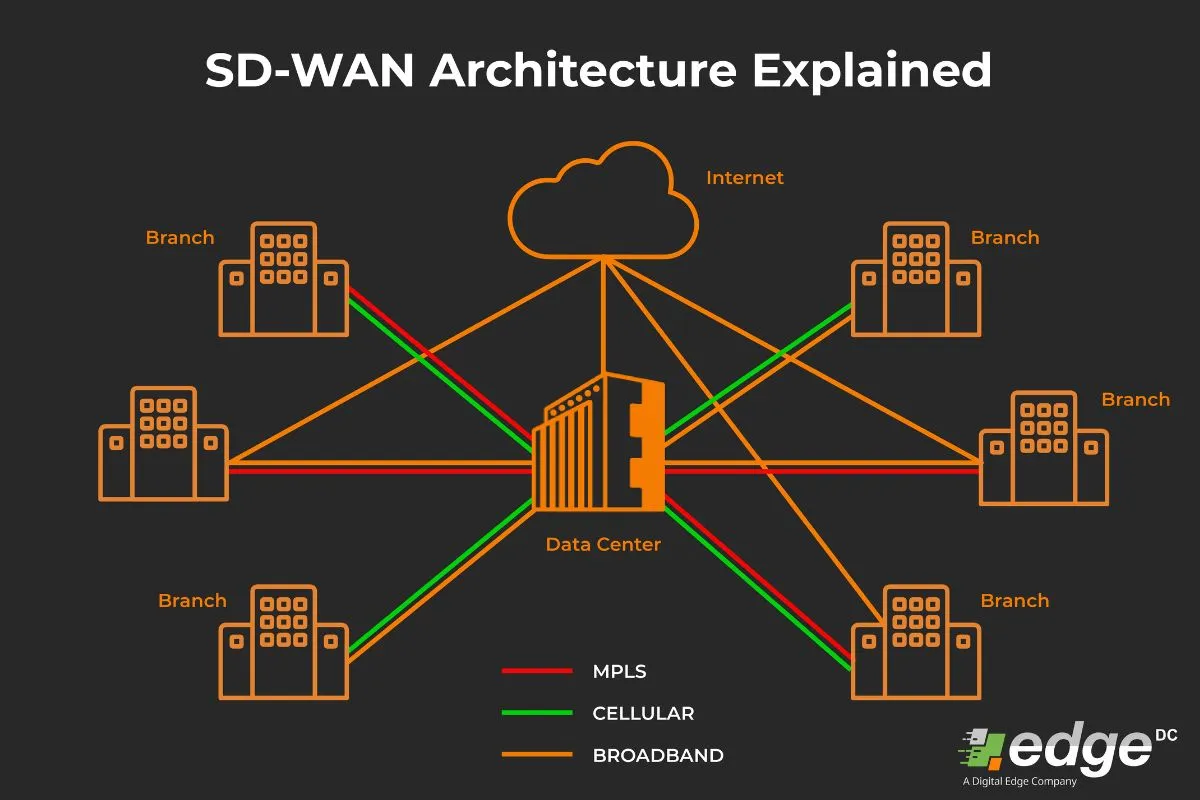For an organization with branch offices spread across various regions, a network that is interconnected, secure, and reliable is one of the challenges that must be overcome. To address this, Wide-Area Network (“WAN”) technology emerged with all its advantages and conveniences.
However, innovation doesn’t stop there. While most of us still use traditional WANs, it’s time we get acquainted with a new technology called Software-Defined Wide Area Network (SD-WAN), which offers significantly better performance and flexibility.
In this article, we will invite you to understand what SD-WAN is, how it works, its benefits for modern businesses, and its crucial role in optimizing connectivity to Data Centers.
Understanding SD-WAN
What is SD-WAN? SD-WAN is a network architecture approach that intelligently optimizes and manages Wide Area Networks through software. This technology enables centralized and automated network control, replacing reliance on rigid conventional hardware.
The core of SD-WAN is the use of Software-Defined Networking (SDN), which allows for the abstraction of the control plane from the forwarding plane. This means SD-WAN can dynamically route data traffic across various connection types (MPLS, broadband internet, 4G/5G LTE, etc.) based on predefined policies.
Through SD-WAN, organizations can create a simpler, more automated network infrastructure, often supporting Zero-Touch Provisioning (ZTP), allowing device deployment at branch locations with minimal manual configuration.
In general, SD-WAN can be defined as a network technology that can be utilized to optimize and manage WAN by leveraging software to control data traffic in a simpler, more efficient, and effective way. This enables seamless integration of various network types, from public internet connections, wireless networks, to existing Multi-Protocol Label Switching (MPLS), tailored to the organization’s performance and cost needs.
How SD-WAN Works

The fundamental difference between what is SD-WAN and traditional WAN lies in their architectural approach. Traditional WANs are generally built on exclusive circuits and heavily rely on dedicated hardware at each location, requiring complex manual configuration and high operational complexity.
SD-WAN works in a much more flexible and intelligent way:
1. Network Abstraction
SD-WAN separates the network control function (the brain) from the data forwarding function (the path). This allows network management to be done centrally via a software-based controller.
2. Aggregation & Tunneling
SD-WAN leverages tunneling (e.g., IPsec VPN) over various existing network infrastructures. This means it can combine multiple connection paths (e.g., two broadband connections and one MPLS) into a single, more reliable, and high-performance logical link.
3. Application Intelligence
The SD-WAN controller continuously monitors the conditions of each connection path (latency, jitter, packet loss, bandwidth) and application characteristics. Based on defined policies (e.g., prioritize VoIP and video conferencing), it automatically directs application traffic to the best path in real-time.
4. Centralized Control & Automation
Administrators can configure and manage the entire WAN from a single centralized interface, whether it’s on-premise or cloud-based. This includes defining data traffic rules, security policies, and Quality of Service (QoS).
5. Optimal Access to Cloud and Data Centers
The interconnected networks will then be identified and grouped into several segments, after which data exchange from each network can be monitored via a centralized control system. SD-WAN intelligently routes traffic to Software-as-a-Service (SaaS) or Infrastructure-as-a-Service (IaaS) in the cloud, as well as to the company’s Data Center (whether self-owned or a colocation service), ensuring optimal performance and security. SD-WAN can also monitor various aspects such as latency and network security proactively. Through this mechanism, SD-WAN can work automatically to determine the most effective path for data transmission, which ultimately affects speed and bandwidth consumption efficiency.
Benefits of Using SD-WAN
SD-WAN is a crucial technology whose application is highly relevant for organizations whose businesses heavily depend on network connectivity, especially those adopting cloud computing and Data Center infrastructure. Beyond fast access, SD-WAN also ensures secure network access with the lowest possible risk. Furthermore, here are some of its main benefits:
1. Simplified Operations
With centralized management and application-based routing, a network administrator can easily make changes or create network security rules that best suit needs in real-time. Zero-Touch Provisioning (ZTP) support allows SD-WAN devices to be deployed at branch locations automatically, reducing operational complexity and lowering administrative costs.
2. Flexible Choice of Internet Providers (ISP Agnostic)
SD-WAN allows for the simultaneous use of multiple different ISPs, providing flexibility in choosing an internet provider based on cost, performance, or availability. You can even select different ISPs at each location. This significantly enhances network reliability; when one ISP connection fails, SD-WAN automatically switches to a backup path from another ISP, ensuring uninterrupted operations.
3. Optimized Application Performance
The freedom to create appropriate rules and an automated working system enables SD-WAN to maintain optimal performance for every application. This is crucial for real-time applications such as Voice over IP (VoIP) or video conferencing, or access to critical business applications hosted in the cloud or Data Center, ensuring that Service Level Agreements (SLAs) are met and the user experience remains optimal.
4. Cost Reduction
Because SD-WAN can intelligently integrate and leverage various network types (e.g., redirecting non-critical traffic from expensive MPLS to more affordable broadband internet), organizations can significantly reduce bandwidth costs. Furthermore, SD-WAN maintenance costs are also much lower compared to complex, hardware-based traditional WAN architectures.
5. Enhanced Security
SD-WAN is equipped with robust security systems, including end-to-end encryption, network segmentation, and integration with cloud security services. This authorized system ensures that only legitimate devices and users can access the network, helping protect against DDoS attacks, malware, hacking, and data theft. Many modern SD-WAN solutions also feature integrated firewalls and Unified Threat Management (UTM) functions, which are vital for protecting connectivity to your Data Center.
6. Optimized Connectivity to Data Centers
For organizations that rely on Data Centers—whether on-premise, colocation services, or private cloud—SD-WAN is a crucial solution.
- Prioritized Access and High Performance: SD-WAN can prioritize traffic to vital applications and resources hosted in your Data Center. With intelligent path selection, SD-WAN automatically chooses the best connection path to ensure minimal latency and maximum throughput to the Data Center, which is vital for critical business applications.
- Simplified Branch-to-Data Center Networking: SD-WAN simplifies how branch offices connect to the Data Center. Instead of managing complex point-to-point connections for each branch, SD-WAN provides a simplified and centrally managed architecture.
- Resilience and Business Continuity: By aggregating various connection types, SD-WAN enhances the resilience of Data Center connections. If a primary path experiences an outage, SD-WAN instantly switches to an alternative path, ensuring uninterrupted access to the Data Center and business operations.
- Security Integration: SD-WAN extends security policies from the Data Center across the entire WAN, ensuring that sensitive data accessed from the Data Center remains protected regardless of the user’s location.
Through the explanation of what SD-WAN is above, we now understand its significant potential to enhance and optimize the network performance of companies and their branch offices centrally, especially in ensuring efficient, secure, and reliable connectivity to your Data Center. By utilizing its advanced operational approach, SD-WAN proves to be far superior for application across various applications, locations, and particularly in integrating and optimizing access to Data Center infrastructure.
Ready to optimize your network and Data Center connectivity? Learn more or consult your needs by filling out the form below.

